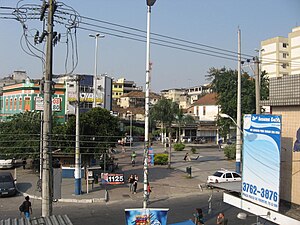Nilópolis
22°48′28″S 43°24′50″W / 22.80778°S 43.41389°W
Nilópolis | |
|---|---|
| Município de Nilópolis | |
 A view of the city | |
| Motto: "Terra da Azul e Branca" | |
 Location of Nilópolis in the State of Rio de Janeiro | |
| Coordinates: 22°48′19″S 43°24′55.91″W / 22.80528°S 43.4155306°W | |
| Country | |
| Region | Southeast |
| State | |
| Founded | August 21, 1947 |
| Government | |
| • Mayor | Abraãozinho David Neto (PL) |
| Area | |
| • Total | 19.157 km2 (7.397 sq mi) |
| [1] | |
| Elevation | 14 m (46 ft) |
| Population (2020 [2]) | |
| • Total | 162,693 |
| • Density | 8,500/km2 (22,000/sq mi) |
| Time zone | UTC-3 |
| Postal Code | 28000-000 |
| Area code | +55 21 |
| Website | www.nilopolis.rj.gov.br |


Nilópolis (Portuguese pronunciation: [niˈlɔpoliʃ], [niˈlɔpɔliʃ], [niˈlɔpuliʃ]) is a municipality in Brazil, located in the Rio de Janeiro state's southwestern region, bordering São João de Meriti, Mesquita and Rio de Janeiro. It is the smallest municipality in Rio de Janeiro state, with a total area of 19.39 km2. The population of 162,693 inhabitants living in an area of 9 km2 and the remaining area corresponds to the Gericinó's Natural Park. Officially, the population density exceeds 8,120 inhabitants/km2, but if calculated just 9 km2 occupied, it becomes the most densely populated city in Brazil with more than 17.400 inhabitants/km2. Currently, São João de Meriti has the highest population density, with 12,897 inhabitants/km2.
The city was named after Nilo Peçanha, a President of Brazil.
Beija Flor
[edit]Nilópolis is famous for its Grêmio Recreativo Escola de Samba Beija-Flor de Nilópolis, one of the most successful and luxurious Samba schools and usually a top contender for winning the carnival parade in Rio.[citation needed]
References
[edit]External links
[edit]- (in Portuguese) Prefeitura de Nilópolis (Nilópolis City Hall)
- (in Portuguese) Baixada Fácil (Nilópolis history)



